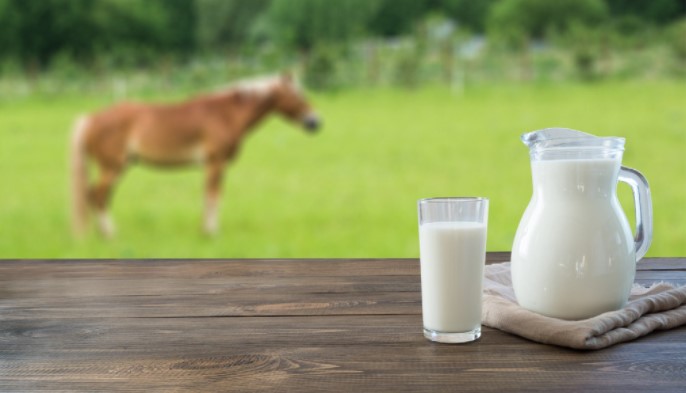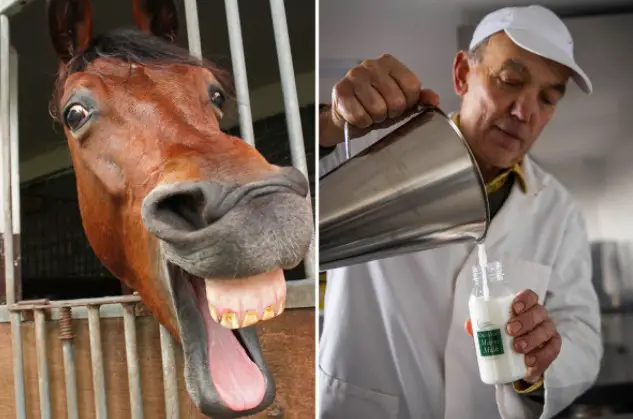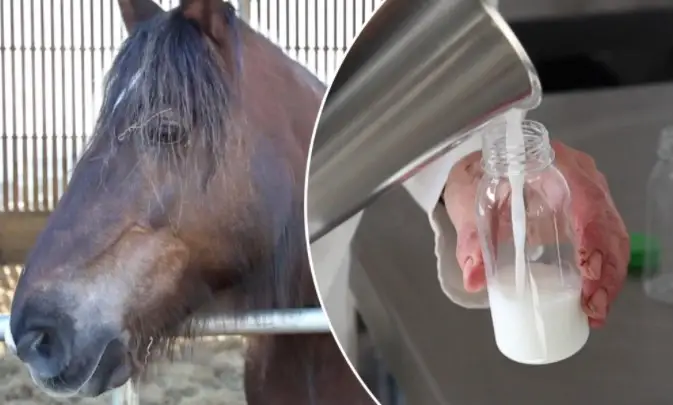Did you know that humans have been milking mares for hundreds of years and that they continue to do so? The ancient Egyptian Queen Cleopatra was known to bathe in donkey milk to maintain her glowing complexion. Even now, horse milk is mostly utilized for aesthetic purposes in Europe. Mare’s and donkey milk are still believed to be beneficial for human skin, and they are frequently found in a variety of cosmetic products. Moreover, donkey milk was utilized in ancient times to nourish orphaned children and heal various skin and liver ailments.
Drinking horse milk is popular in Central Asia, Russia, Tibet, and some portions of China. It is also drunk in some parts of the Middle East. This may appear weird to Western readers; some Europeans, however, do drink mare’s milk. Furthermore, it has been a traditional staple throughout Central Asia for a very long time. Russian doctors originally utilized it as a cure for TB in the mid-19th century. It is widely fermented into “koumiss,” a moderately alcoholic beverage that is commonly consumed today.
However, even though horse milk is healthy and tasty, it is not an efficient food alternative. This is because it is expensive to make, less nutritious, and hard to acquire. After all, it is not widely available as cow or goat milk.
Does Horse Milk have a bad taste?
No, horse milk doesn’t taste bad. However, mare’s milk is thinner than human or cow’s milk because of its low-fat content. But it is still drinkable and does not have a terrible flavor or smell at all. It has a sweeter taste than cow’s milk, with a hint of almond flavor. The reason it is not consumed widely is not the taste.

Benefits of horse milk
Low content of fats and lactose becomes a blessing in disguise for many and makes horse milk beneficial. Some of the main uses of mare milk are following:

- The first and most significant benefit of consuming Horse Milk is less lactose ratio than cow’s milk. Thus it is easily digestible by people of all ages. The antibacterial boost that horse milk provides to the human body helps to rebalance the intestinal flora. Moreover, it helps to alleviate the symptoms of indigestion, bloating, and constipation in many people.
- Horse milk has a relatively modest fat level, with the majority of the fat being monosaturated. This ensures that people drinking horse milk will not suffer from any health difficulties in the future.
- It contains various vitamins, including vitamin A, E, C, etc. Horse Milk has a higher vitamin content than cow’s milk, which makes it a healthier choice.
- The use of horse milk as a detoxifier aids in the removal of toxins and other undesirable chemicals. These chemicals get accumulated in the body over time and cause discomfort. Human bodies get filtered due to the frequent consumption of horse milk, helping individuals maintain optimal health.
- Horse milk contains far less cholesterol than found in human breasts and cow milk. This makes mare milk a perfect choice of nutrition for patients suffering from high cholesterol.
- Several studies have found that horse milk can assist in settling irregular bowel movements and alleviate stomach-related disease. As a result, people’s digestive processes remain healthy, which is necessary for sustaining good health.
- It has been demonstrated that drinking horse milk can boost bone density in humans. This means horse milk has the potential to protect against osteoporosis by avoiding bone and joint pain.
Why do we not drink horse milk?
Despite the benefits mentioned above, there are many drawbacks related to it. These drawbacks are what hinder the consumption of mare milk around the world.

Offers Low Nutritional Value
Despite the numerous health advantages, horse milk is no replacement for human breast milk. When we compared the cow’s milk with horses’ milk, we found that the latter contained far more water. And, as a result, contains significantly less fat, protein, and other vital components. This makes horse milk less likely to be used as a proper diet.
Production is low
Horses are currently preserved and bred for various purposes, including racing, beauty contests, and aesthetic preferences. So, milk production is considered second or third preference when it comes to horses. The first and utmost priority is to feed the neonate, baby horse. A mare can produce up to 12 liters of milk a day, and only one liter can be considered spare.
Did you know that the mother horse only lactates while her foal is present by her side?
For the health of the foal
As stated earlier, a mare can only provide a liter of spare milk. The rest is utilized for the nourishing of her foal. Just like you will not clean your carpet with a lawnmower, because both have different purposes. Similarly, horses were never meant or utilized only to produce milk for human use.
So, a question might arise in your mind:
“Why don’t we promote the horse breeds that produce more milk?”
Well, we do. Horse milk production is improving all of the time. This business is revitalizing itself. But it is still a reality that the essential function of a breeding mare is to produce a healthy, active, well-fed foal that will grow up to be a robust, powerful, and superb horse. As a result, milk production for human consumption is unquestionably a secondary concern.
Beneficial alternatives are available
Despite the pharmacological and aesthetic benefits of horse milk, it is not as nutritious as the milk of cows, buffaloes, sheep, and even goats. The protein and fat level of equine (horse) milk is lower than the alternatives. So, using horse milk as a nutritious source doesn’t make sense in the presence of other options available.
Also, several methods, including artificial selection, purposeful breeding, and genetic manipulation, have been used to generate high-milk-producing dairy cows and goats. Mares, on the other hand, were never meant to deliver milk for people.
The lesser population of horses
There are around 60 million horses in the world. When compared to the world’s more than one billion dairy cows, this is a pitiful number. There are not enough horses to meet the needs of the human population, and there will never be enough.
Other prohibitory factors
- A mare needs to be milked 3 to 5 times a day. Unlike a cow that needs milking twice a day.
- They have smaller teats (mammary glands) which make milking even harder. Sometimes, machines are used to reduce the manual work they require.
- The gestation period of a mare is way less than that of cattle and goats. Also, two months after the foal’s birth, the milk production lowers to a great extent.
- As a horse has more body mass and weight than a cow or goat, its maintenance and nutrition will be costly.
- Handling a horse is way more complicated than handling other domestic animals for milking. Let us give you a life-saving tip if your horse is not entirely familiar with your touch. Tie one front leg. It will restrict the mare from kicking. And make sure you milk the mare in the presence of her foal.
In Conclusion
So, now we can conclude that horse milk is nutritious for certain people despite its economic difficulties in availability. So, let us know if you have ever tried a sip or not!
